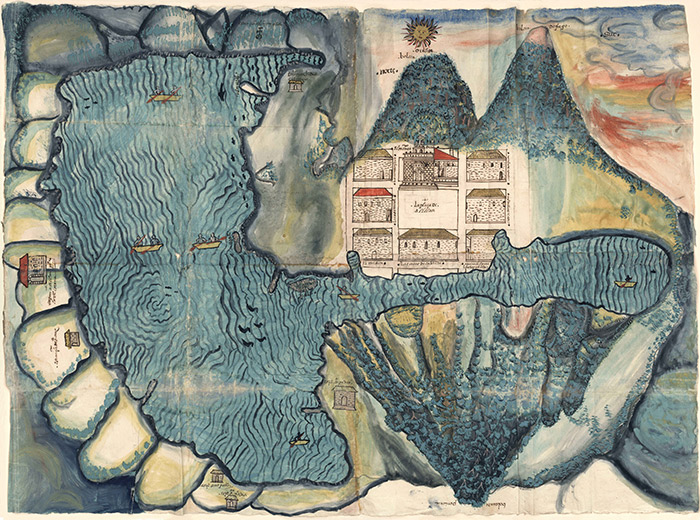Posted on Wed., Jan. 3, 2018 by

Eighth-graders from the Arroyo Seco Museum Science Magnet School in Los Angeles view maps at the exhibition “Visual Voyages: Images of Latin American Nature from Columbus to Darwin.” Photo by Martha Benedict.
Last fall, roughly 100 sixth-graders from the Charles W. Eliot Arts Magnet Academy in Altadena, Calif., and 75 eighth-graders from the Arroyo Seco Museum Science Magnet School in Los Angeles came to The Huntington to take part in daylong learning experiences inspired by the exhibition “Visual Voyages: Images of Latin American Nature from Columbus to Darwin,” which is on view in the MaryLou and George Boone Gallery through Jan. 8, 2018.
Teachers familiarized students with the exhibition ahead of their visits through The Huntington’s “Visual Voyages” instructional tool, an online resource of images and text drawn from the exhibition catalog and labels, and studded with compelling questions intended to stimulate discussion and critical thinking.

Unknown artist, Relación geográfica map of Santiago Atitlán, 1585, ink and watercolor on paper, 24 3/16 x 31 7/8 in. (61.5 x 81 cm.), Joaquín García Icazbalceta Manuscript Collection, Nettie Lee Benson Latin American Collection, The University of Texas at Austin, JG xx-10.
Once at The Huntington, the students participated in the Visual Voyages Deep Learning Day Program—a learning experience co-facilitated by The Huntington’s education staff and docents, as well as an art educator. During the day, the students enjoyed a cross-collections tour, showcasing “Visual Voyages” and the related exhibitions “Sonic Botany” and “Nuestro Mundo,” as well as a range of complementary stops in the gardens. Then, during the tour, they pondered several provocative questions as they reflected, in particular, on the roles played by indigenous people and women during the time period covered by the exhibition.
Inspired by the tour, the students afterward engaged in hands-on art-making, creating a personal map to share with others. Students also had the opportunity to reflect on and showcase their knowledge of the exhibition through the crafting of a “found poem” in English and Spanish.
“Connecting what they see in the morning with what they do and learn in the afternoon is the key to the program,” says Louise Hindle, public school specialist at The Huntington. “They learn how to engage with the collections and better understand what it means to curate and collect through creative responses.”

Denise Seider (second from right), an art educator at Eliot Arts Magnet Academy, leads an art-making project as part of a Visual Voyages Deep Learning Day at The Huntington. Photo by Martha Benedict.
Denise Seider, an art educator at Eliot Arts Magnet Academy, led the art-making part of the afternoon—the creation of personal maps prompted by maps in the exhibition, such as the 1585 map of Santiago Atitlán, a municipality in present-day Guatemala.
This map was painted in response to a survey distributed by the Spanish Council of the Indies in 1577 to town officials in Mexico and Central America. The goal of the questionnaire was to compile information about each town, including its infrastructure, geography, landscape, flora, fauna, and minerals.
Local artists painted maps that showed both the continuity of native traditions and the radical changes introduced by Europeans. Elements from indigenous art include pictographs providing place names, footprints indicating roads, and wavy lines and whirlwinds marking bodies of water. Such maps presented local visions of the landscape at a time of rapid cultural and social transformation.

Students crafting their “found poem” in English and Spanish from words that appear in the “Visual Voyages” catalog and exhibition labels. Photo by Martha Benedict.
After students studied the maps, Seider led them in a discussion about how contemporary maps, digital and printed, differed from maps in the exhibition. She then taught them how to create a mixed-media collage representing a personal journey. They could take their inspiration from their daily travel to school, their trip to The Huntington, or a journey made by themselves or their ancestors. Students used cut images, maps, and oil pastels to create their artwork.
In addition to personal map making, all students used a collection of words, taken from the exhibition labels and literature, to compose free-verse, found poems. Just like the exhibition labels, the words were in English and Spanish, and opened up the opportunity for students to write a dual-language poem, while simultaneously giving them a moment to reflect, make meaning, and find their creative voices.

A “found poem” by one of the participants in The Huntington’s Visual Voyages Deep Learning Program. Photo by Louise Hindle.
When asked what was the most interesting thing they did or learned on the field trip, several students responded that they liked creating the art and poems. Others enjoyed touching a taxidermy armadillo, looking at a feathered cape, or learning how cacao is turned into chocolate.
And one student summed up the experience like this: “The most interesting thing I did was walk around The Huntington, looking at amazing art and nature.”
Kevin Durkin is editor of Verso and Huntington Frontiers, and managing editor in the office of communications and marketing at The Huntington.